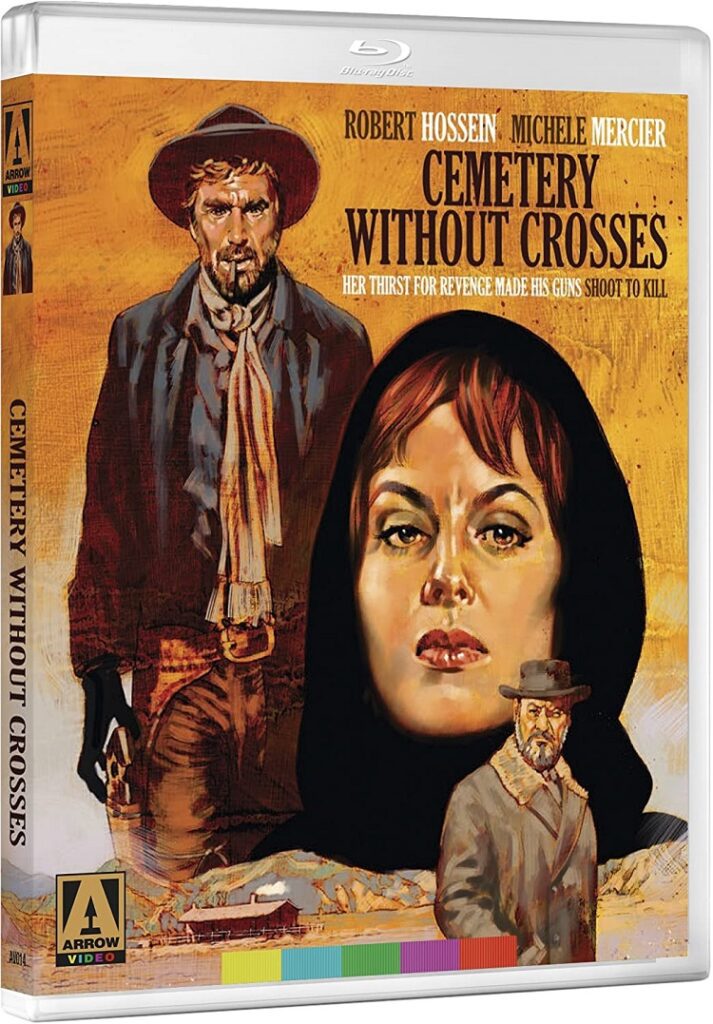
Filmed in Spain, with a mostly French cast directed by (and starring) the French Robert Hossein and with a screenplay co-credited to the Italian Dario Argento, Cemetery Without Crosses is, of course, a Western set in Texas. It’s interesting to consider how the Western, which had captured the imagination of the world enough that a cottage industry of European Westerns existed for decades, has now almost completely disappeared. Genres come and go (the screwball comedy has never been really successfully revived, and whenever a modern musical comes around to “revive the genre” is does so by not looking, or feeling much like a musical) but the Western seemed to have a universal quality that it has, somehow, lost.
Cemetery Without Crosses represents a childhood dream of its filmmaker who, born in 1927, grew up on Westerns and always wanted to make his own. According to an interview found on this Blu-ray, this was the first French Western. In terms of tone and filmmaking, though, it owes most of its allegiance to Sergio Leone’s Clint Eastwood trilogy and its majestic follow-up Once Upon a Time in the West (which Hossein was originally supposed to have a part in.) Hossein and Leone were good friends. He even let Sergio Leone direct one of the long sequences in this film, when the gunslinger Manuel sits down to dinner with the Rogers family who has employed him on their ranch after he helped out their sons in a bar fight.
What they don’t know is that Manuel is infiltrating the Rogers to exact revenge on them. The Rogers rode down and killed Ben Caine, who happens to be married to an old flame of Manuel’s, Maria. Caine’s brothers just want to flee to Mexico. Maria wants to do to the Rogers family what’s been done to her.
Manuel has given up his gunslinging ways, though, and doesn’t much relish getting involved in Maria’s troubles. He apparently lives in a ghost town (details in Cemetery Without Crosses seemed picked much more for their style and look than for any particular logic) and is just waiting around there for Maria to show up, so he can tell her he doesn’t want to help her, and then does it anyway.
Style is the reason for watching this movie. The story is fairly typical of revisionist Westerns. Everyone’s amoral, and has a past they don’t want to revisit but can’t get away from. There’s not much dialogue. Our hero’s not much of a hero – to get in good with the Rogers, he shoots down some townies who have just as much reason to hate the Rogers as Maria. His plan for revenge involves kidnapping the Rogers’ sister, and leaving her to Maria’s cruel devices. And the Rogers themselves were riding out against the Caines because they robbed them – maybe taking back what was theirs, maybe not. It’s all deliberately murky.
And it all happens so we can immerse ourselves in the style. In that bar fight that ends with Manuel demonstrating his gunslinging prowess, he stands in the background while Rogers is dressed down by the angry townsman. Without calling attention to himself, Manuel puts a black glove on his right hand. His shooting glove. There’s a scene where he’s chasing down the Rogers sister who is escaping from her prison, and we watch a long, long shot of his following behind her on a horse while she runs, until she sees two more riders coming down the path – the Caine brothers, and she turns, preferring to be caught by Manuel than by them.
It offers many of the pleasures of the Western – the wide-open vistas, the emphasis on deliberate action over dialogue, the constant underlying theme of the brutality of man and the harshness of nature. It’s enjoyably laconic, with a fun score that emulates Ennio Morricone’s own efforts, and has a great song sung by Scott Walker over the opening and ending credits. I was not entirely engaged by it, since the moral ambiguity (and occasional downright amorality) made it hard to pick a side to root for. But I liked watching it, all the same.
The Blu-ray comes with both English and Italian audio – each are dubbed. I didn’t watch the entire film through in both languages, but in spot checking found in some scenes there was more dialogue in the Italian version than the English, which in my opinion made the latter more powerful: some scenes that have dialogue from Manuel in Italian are played in the English version without a word. While this print of the movie credits Dario Argento with co-writing the screenplay, Hossein (so IMDB Trivia informs me) denies he had written any part of it. Also on the Blu-ray is a recent interview with Hossein about the film, and some fun (though brief) TV interviews contemporary to the film’s release.